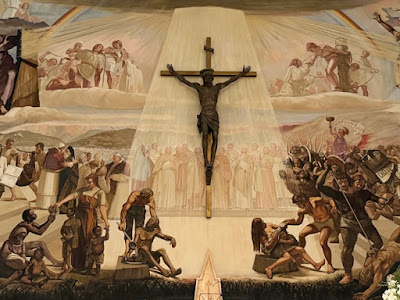Massa
Massa is located in northwest Tuscany, on the western slopes of the Apuan Alps, about 5 km from the Ligurian Sea. The Malaspina Castle stands proudly on the hill. It can be viewed from any angle in the surrounding plain and its position offers outstanding panoramic views over the neighbouring land and sea.
Massa is split into two distinct areas, eight kilometres apart from each other: the main area of the city lies inland in a slight elevated position while Marina di Massa is a seaside beach resort. We visited the historic centre on a freezing and rainy day in April 2024 and Marina di Massa, a few days later during a sunny afternoon after visiting the Orto Botanico delle Alpi Apuane Pietro Pellegrini.

Massa is a city with ancient roots. At the well-preserved historic centre, you can still breathe the medieval atmosphere. We began our visit from the main square, Piazza Aranci, named after the two rows of orange trees that surround it on three sides. On the eastern side stands the Ducal Palace. It is also known as Palazzo Rosso or Palazzo della Prefettura. The Palace is dated 1563, originally in Renaissance style but evolved to Baroque appearance in the following centuries. The exterior is characterised by the vast presence of windows decorated with marble stuccoes and portals. It is currently home to the city’s Provincial Administration.
An obelisk, dating to 1853, stands in the middle of the piazza. It is flanked by a striking fountain embellished with four statues of lions.
We then proceeded to Piazza Mercurio, a nice square with a column and Mercury atop. Nobody other than us could be seen nearby. It started to rain. We went to a coffee shop and looked for information of the Malaspina Castle. Only a few English websites mentioned it. It seemed that it was opened. The weather turned better. We headed out. The Piazza Mercurio with sunshine looked fresh and lovely.
Nearby is Massa’s cathedral (Cattedrale dei Santi Pietro e Francesco). It was originally a pieve (a rural church with a baptistery) dedicated to Saint Peter but transferred to Saint Francesco. The Cathedral was built on the previous convent of San Francesco. The façade is a reconstruction in 1936 while in the basement is the Cybo-Malaspina burial ground.
The cathedral houses precious works such as a Madonna and Child by Pinturicchio, a crib made by Benedetto Buglioni in coloured terracotta and the marble altars made by Bergamini.
Sunshine at the Piazza Mercurio lasted for a short while only. Dark clouds loomed over the way we walked up to the Malaspina Castello. The high up places offer supreme views over the city and the neighbouring areas.
Until we approached the castle, we saw a notification that the castle was closed for restoration until further notice. So sad that we could not see the mighty premises consisting of bastioned walls full of gun ports and loopholes, the residential palace, and the original medieval keep. At time of writing, 3 months after, the castle is still closed as shown at Google Map.
The interior is decorated with a cycle of frescoes by various painters. Frescoes depicting the old and new testaments are presented in each vertical panel, such as the resurrection of Lararus vs. the revitalizing skeletons described in the book of Ezekiel, the return of the prodigal son vs. the drive away of Adam and Eve from the Garden of Eden, etc. The enormous fresco behind the main altar is beautiful and vividly represents, both in colors and images, the Last Judgment, divided in half by a bronze crucifix.
The Arco del Salvatore refers to the monumental gate that led to the western part of the city of Massa. It is a recovery and transformation of the more ancient Porta di S. Francesco, built in the 16th century with a double door. To celebrate the birth of the Duchy of Massa, Duke Charles II transformed the primitive defensive structure into a monumental triumphal arch. The opening of the arch was covered with large ashlars in cavernous limestone. A statue of the Savior was inserted on the door in 18th century, which gave it its current name.
Teatro Guglielmi was constructed in 1880 as a courtly theatre and named after Alessandro Guglielmi, a musician from Massa. The theatre is one of the most elegant buildings in the city and has a striking neoclassical façade with a large portico supporting the external aisle.
For those reaching Massa on foot from the railway station will not miss the Fontana dei Putti, commonly called "of the four asses", located at the entrance to the town. The fountain was inaugurated in 1928 and restored in around 2020. It is made with white Apuan marble. In the centre are 4 dolphins supporting a rotating sphere. At the circumferences are 4 joyful putti sitting on their respective shell.
We visited Marina di Massa after a visit to the mountain botanical garden on a Sunday evening. It is a famous seaside resort flanked by the coast and the Apuan Alps. People dotted the beaches with fine sand. Some plunged into the water in late April whereas a week ago the temperature at Massa was 3°C in the morning.
 |
| Toscana-info |
We continued to reach the Pier which offers a suggestive walk on the sea and a look at the gorgeous mountains. Many locals came in groups to enjoy chatting and the beautiful weather. Alone fishermen were here and there to wait for their catch. The atmosphere was happy.

It is easy to reach Massa even you don't drive. Massa's train station is called Massa Centro and it lies 2 kilometres from the historic centre, a 20-minute walk or a 5-minute bus ride (routes L60 or L61), followed by a 5-minute walk. It takes 30 minutes to reach La Spezia. For Florence, the journey time is less than 2 hours.























Comments